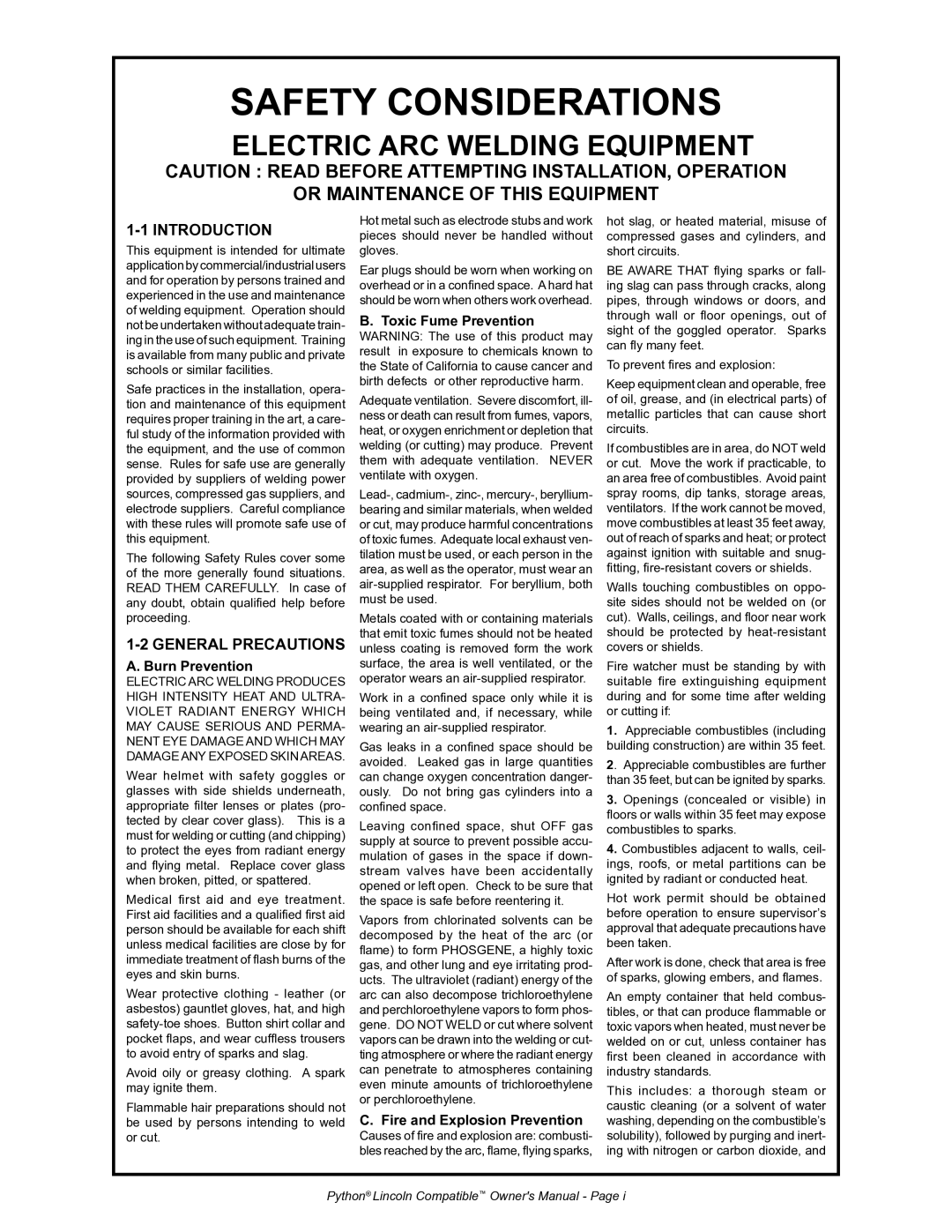
Safety Considerations
ELECTRIC ARC WELDING EQUIPMENT
CAUTION : READ BEFORE ATTEMPTING INSTALLATION, OPERATION
OR MAINTENANCE OF THIS EQUIPMENT
1-1 INTRODUCTION
This equipment is intended for ultimate application by commercial/industrial users and for operation by persons trained and experienced in the use and maintenance of welding equipment. Operation should not be undertaken without adequate train- ing in the use of such equipment. Training is available from many public and private schools or similar facilities.
Safe practices in the installation, opera- tion and maintenance of this equipment requires proper training in the art, a care- ful study of the information provided with the equipment, and the use of common sense. Rules for safe use are generally provided by suppliers of welding power sources, compressed gas suppliers, and electrode suppliers. Careful compliance with these rules will promote safe use of this equipment.
The following Safety Rules cover some of the more generally found situations. READ THEM CAREFULLY. In case of any doubt, obtain qualified help before proceeding.
1-2 GENERAL PRECAUTIONS
A. Burn Prevention
ELECTRIC ARC WELDING PRODUCES HIGH INTENSITY HEAT AND ULTRA- VIOLET RADIANT ENERGY WHICH MAY CAUSE SERIOUS AND PERMA- NENT EYE DAMAGE AND WHICH MAY DAMAGE ANY EXPOSED SKIN AREAS.
Wear helmet with safety goggles or glasses with side shields underneath, appropriate filter lenses or plates (pro- tected by clear cover glass). This is a must for welding or cutting (and chipping) to protect the eyes from radiant energy and flying metal. Replace cover glass when broken, pitted, or spattered.
Medical first aid and eye treatment. First aid facilities and a qualified first aid person should be available for each shift unless medical facilities are close by for immediate treatment of flash burns of the eyes and skin burns.
Wear protective clothing - leather (or asbestos) gauntlet gloves, hat, and high
Avoid oily or greasy clothing. A spark may ignite them.
Flammable hair preparations should not be used by persons intending to weld or cut.
Hot metal such as electrode stubs and work pieces should never be handled without gloves.
Ear plugs should be worn when working on overhead or in a confined space. A hard hat should be worn when others work overhead.
B.Toxic Fume Prevention
WARNING: The use of this product may result in exposure to chemicals known to the State of California to cause cancer and birth defects or other reproductive harm.
Adequate ventilation. Severe discomfort, ill- ness or death can result from fumes, vapors, heat, or oxygen enrichment or depletion that welding (or cutting) may produce. Prevent them with adequate ventilation. NEVER ventilate with oxygen.
Metals coated with or containing materials that emit toxic fumes should not be heated unless coating is removed form the work surface, the area is well ventilated, or the operator wears an
Work in a confined space only while it is being ventilated and, if necessary, while wearing an
Gas leaks in a confined space should be avoided. Leaked gas in large quantities can change oxygen concentration danger- ously. Do not bring gas cylinders into a confined space.
Leaving confined space, shut OFF gas supply at source to prevent possible accu- mulation of gases in the space if down- stream valves have been accidentally opened or left open. Check to be sure that the space is safe before reentering it.
Vapors from chlorinated solvents can be decomposed by the heat of the arc (or flame) to form PHOSGENE, a highly toxic gas, and other lung and eye irritating prod- ucts. The ultraviolet (radiant) energy of the arc can also decompose trichloroethylene and perchloroethylene vapors to form phos- gene. DO NOT WELD or cut where solvent vapors can be drawn into the welding or cut- ting atmosphere or where the radiant energy can penetrate to atmospheres containing even minute amounts of trichloroethylene or perchloroethylene.
C.Fire and Explosion Prevention
Causes of fire and explosion are: combusti- bles reached by the arc, flame, flying sparks,
hot slag, or heated material, misuse of compressed gases and cylinders, and short circuits.
BE AWARE THAT flying sparks or fall- ing slag can pass through cracks, along pipes, through windows or doors, and through wall or floor openings, out of sight of the goggled operator. Sparks can fly many feet.
To prevent fires and explosion:
Keep equipment clean and operable, free of oil, grease, and (in electrical parts) of metallic particles that can cause short circuits.
If combustibles are in area, do NOT weld or cut. Move the work if practicable, to an area free of combustibles. Avoid paint spray rooms, dip tanks, storage areas, ventilators. If the work cannot be moved, move combustibles at least 35 feet away, out of reach of sparks and heat; or protect against ignition with suitable and snug- fitting,
Walls touching combustibles on oppo- site sides should not be welded on (or cut). Walls, ceilings, and floor near work should be protected by
Fire watcher must be standing by with suitable fire extinguishing equipment during and for some time after welding or cutting if:
1.Appreciable combustibles (including building construction) are within 35 feet.
2. Appreciable combustibles are further than 35 feet, but can be ignited by sparks.
3.Openings (concealed or visible) in floors or walls within 35 feet may expose combustibles to sparks.
4.Combustibles adjacent to walls, ceil- ings, roofs, or metal partitions can be ignited by radiant or conducted heat.
Hot work permit should be obtained before operation to ensure supervisor’s approval that adequate precautions have been taken.
After work is done, check that area is free of sparks, glowing embers, and flames.
An empty container that held combus- tibles, or that can produce flammable or toxic vapors when heated, must never be welded on or cut, unless container has first been cleaned in accordance with industry standards.
This includes: a thorough steam or caustic cleaning (or a solvent of water washing, depending on the combustible’s solubility), followed by purging and inert- ing with nitrogen or carbon dioxide, and
Python® Lincoln Compatible™ Owner's Manual - Page i
